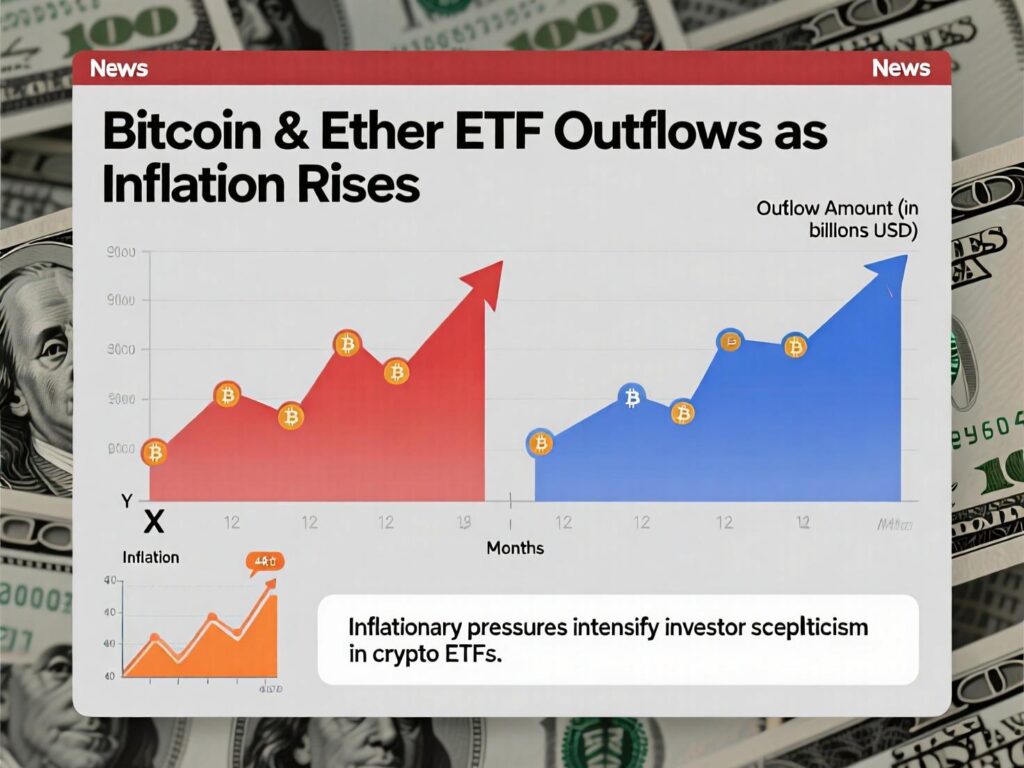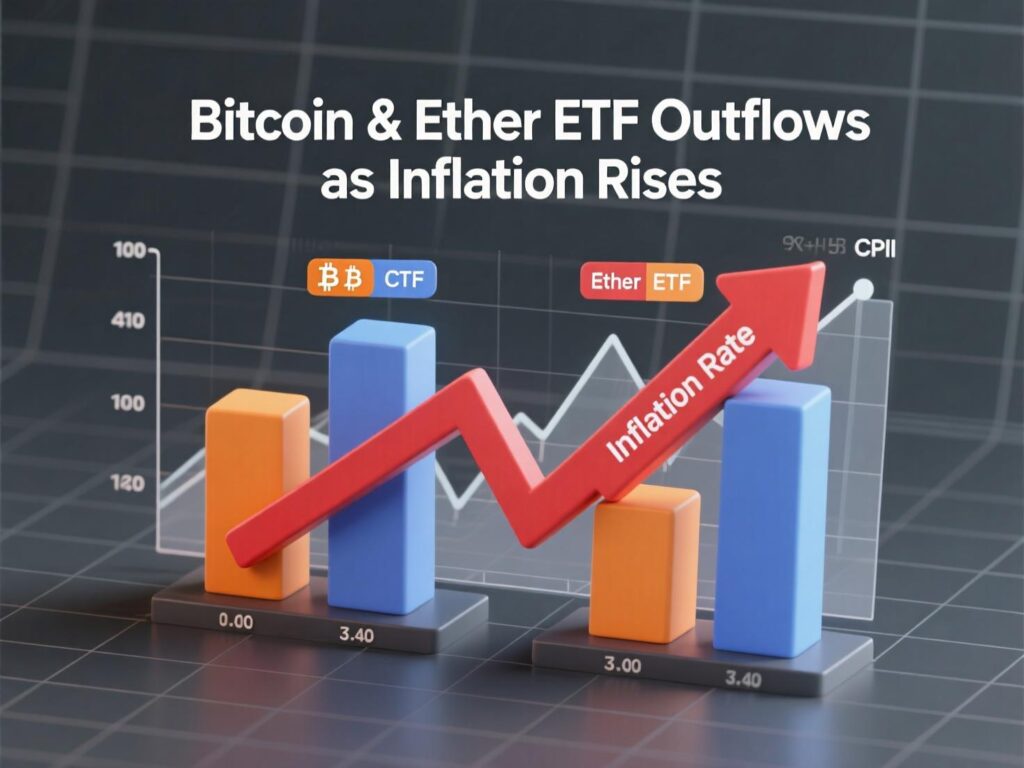Spot BTC, ETH ETFs see outflows as inflation ticks up under Trump tariffs
Spot crypto ETFs saw significant outflows on Friday as hotter-than-expected U.S. inflation data rattled markets. The fresh numbers triggered renewed doubts over the timing of potential Federal Reserve rate cuts, dampening investor sentiment across risk assets, including digital currencies. With inflation still sticky, traders pulled back from crypto-linked funds, highlighting how macroeconomic pressure continues to shape market flows.
At the same time, trade dynamics added further strain as elevated tariffs pushed import costs higher, compounding economic uncertainty. Against this backdrop, El Salvador quietly took steps to fortify its Bitcoin holdings by redistributing its national reserve across multiple wallets, a move designed to bolster security and resilience. Together, these developments underscored the fragile balance between global policy shifts, inflationary pressures, and the evolving role of crypto in sovereign strategy.
What’s driving Bitcoin and Ether ETF outflows as inflation rises?
The Fed’s preferred gauge, core PCE, rose 2.9% year-over-year in July, the highest since February. While the print matched forecasts, traders read it as evidence that price pressures are re-accelerating. Market chatter tied a portion of those pressures to the current tariff regime—baseline 10% on all imports plus targeted reciprocal duties—keeping services inflation sticky even as energy muted the headline. The macro takeaway: a still-inflationary backdrop that can sap demand for higher-beta exposures like crypto.
Friday’s ETF scorecard: who sold, who bought
Ether spot ETFs: Net outflow of $164.64M, snapping a five-day inflow streak that had added over $1.5B to the category.
Bitcoin spot ETFs: Net outflow of $126.64M, the first daily loss since Aug. 22.
AUM check: Roughly $28.58B for Ethereum funds and $139.95B for Bitcoin funds.
Fund-level standouts: Fidelity’s FBTC logged the largest single-day outflow at $66.2M; ARKB saw $72.07M in withdrawals; GBTC shed $15.3M. On the inflow side, BlackRock’s IBIT added $24.63M, while BTCW gained $2.3M.
Taken together, the tape reflected Bitcoin and Ether ETF outflows as inflation rises, with investors trimming exposure at the margin while a few vehicles still attracted selective bids.

Rates path: cut hopes vs. sticky services
Despite the firmer core PCE and ongoing tariff effects, futures still price a decent chance of a Fed rate cut at the next meeting conditional on softer labor data. This push-pull (sticky services vs. cooling growth) tends to create choppy crypto flows: macro-sensitive holders fade strength, while long-term allocators nibble on dips. That tension helped shape Bitcoin and Ether ETF outflows as inflation rises, without sparking a wholesale exodus.
Under the hood of Ether demand
Zooming out from Friday, Ether spot ETFs have been a bright spot since their July 2024 debut. August net inflows rose ~44%, advancing from $9.5B to $13.7B, as institutional interest rebuilt after a long stretch of ETH underperformance. Corporate treasuries now hold about 4.4M ETH (~3.7% of supply), an adoption datapoint that supports the thesis of Ethereum as productive collateral for staking, enterprise tooling, and onchain services. As one CIO put it, improving sentiment reflects renewed recognition of ETH’s adoption curve and value proposition context that partly offsets headline-driven risk aversion.
Policy watch: the tariff channel
A baseline tariff on all imports, layered with reciprocal duties, can lift input costs and pass through to core prices. While not the sole driver, that framework helps explain why services inflation remains firm even as goods disinflate. For crypto, the mix of higher-for-longer real yields and growth uncertainty is a classic headwind—that’s why Bitcoin and Ether ETF outflows as inflation rises tend to cluster around hot inflation releases.
Security watch: El Salvador splits its Bitcoin across 14 wallets
Separately, El Salvador moved its 6,274 BTC (≈ $678M) from a single address into 14 new wallet addresses, reportedly capping each at ≤500 BTC. The country framed it as risk segmentation against hypothetical future quantum threats: once a UTXO is spent, the public key becomes visible, and if quantum computers ever reach practical Shor’s algorithm breakpoints older exposed keys could, in theory, be targeted.
Experts stressed that quantum-capable key-cracking remains nowhere near practical today, but applauded the operational hygiene: reduce single-address exposure, minimize blast radius, and keep optionality for protocol/hardware upgrades if the threat landscape ever changes.

Bottom line
Hotter core PCE data and tariff-driven service costs revived inflation worries, sparking outflows from Bitcoin and Ether ETFs. Investors trimmed exposure as rate-cut hopes weakened, though the selling looked tactical rather than a full retreat. The moves reflected how sensitive digital assets remain to shifting macro signals.
Still, structural demand is quietly building. Ether’s ETF inflows and early treasury adoption suggest a durable bid beneath short-term volatility. Meanwhile, El Salvador strengthened security by splitting its national Bitcoin holdings across multiple wallets—an example of how the market is maturing and adapting to both economic pressures and technological risks.
FAQs
Q1 . What triggered Bitcoin and Ether ETF outflows as inflation rises?
A : A firmer core PCE print and tariff-related cost pressures nudged investors to de-risk, producing modest, broad-based selling across spot crypto ETFs.
Q2 . Are rate cuts still on the table after the latest core PCE?
A : Yes if labor data softens further. Traders still price a possible cut, but sticky services inflation keeps the Fed cautious.
Q3 . Which Bitcoin ETFs saw the biggest moves on Friday?
A : FBTC posted the largest outflow, ARKB also saw notable withdrawals, while IBIT and BTCW drew small inflows.
Q4 . Why did El Salvador split its BTC into 14 wallets?
A : It’s an operational security measure to minimize single-address exposure and hedge against long-horizon, theoretical quantum risks.
Q5 . Is Ethereum still attracting institutions despite the pullback?
A : Yes. Post-launch momentum continued in August, and corporate treasuries now hold millions of ETH supporting long-term adoption narratives.

